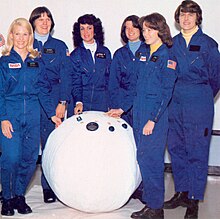Personal Rescue Enclosure
The Personal Rescue Enclosure (German about one-man rescue capsule ), also called Rescue Ball (German rescue ball ) or PRE , is a small space capsule without its own drive. It was developed as a prototype from 1975 on behalf of NASA , but was not used in practice. Her planned mission was to rescue space travelers from one space shuttle to another in a scenario where there are not enough spacesuits available.
background
Two space shuttles could not dock with each other. In a possibly necessary rescue scenario in which the crew of one space shuttle were to switch to another, the entire crew would therefore have had to go on an outboard mission . However, in the early days of the space shuttle program, spacesuits were not carried for all crew members. That is why the PRE was developed.
Even if there were problems with the life support system on board, the PRE would have offered the crew refuge.
history
The order to develop the Rescue Ball was awarded in 1975 by NASA to the space suit manufacturer ILC Dover . A combination of budget constraints, weight problems and available space in the space shuttle did not let the project get beyond the experimental stage and it did not fly on any shuttle mission .
Since the Challenger disaster , all crew members wore spacesuits during the critical phases of the mission.
However, even after development was discontinued, PREs were still used in the selection process for astronaut candidates in order to observe their reaction to confined spaces and stressful situations.
Working principle
The PRE is a minimal space ship in spherical shape with a diameter of 86 cm and an internal volume of 0.33 m 3 . The PRE is made of fabric and when it was not under pressure, it could be stowed away to save space. Due to the compact design, up to five PREs could have been carried on board the space shuttle.
A three-layer outer skin protects the passenger from the vacuum , heat and cold in space : an inner layer made of polyurethane , a middle layer made of Kevlar and a white heat protection layer on the outside. A small porthole made of Lexan and a communication system were used to communicate with the outside world.
Entry was through an opening that could be closed with a zip . The astronaut entered the PRE with his legs strongly bent (in an embryonic position), which was then locked by another spaceman. An oxygen mask was put on to provide breathing air and a container with oxygen and carbon dioxide absorbers was carried for a survival time of one hour. While the PRE was still in the airlock , an umbilical cord took over the air supply.
After opening the airlock, the rescue ball should be transported to the rescue ship by another astronaut in a space suit. The ball should then be returned and the procedure repeated until all crew members have been taken to the rescue ship. Alternatively, the transport with the robotic arm remote manipulator system or with a dinghy rope (similar to rescuing shipwrecked people with a trouser buoy ) was planned.
See also
Web links
Individual evidence
- ↑ William Ayrey: ILC Space Suits & Related Products. 0000-712731 Rev. A . November 28, 2007, p. 93-95 ( PDF; 13.1 MB ).
- ↑ a b c d Rescue Ball in the Encyclopedia Astronautica , accessed on October 18, 2017 (English).
- ^ A b David J. Shayler: Space Rescue: Ensuring the Safety of Manned Spaceflight . Springer , Berlin / Heidelberg / New York 2009, ISBN 978-0-387-73996-0 , pp. 10-14 , doi : 10.1007 / 978-0-387-73996-0 .
- ↑ Kenneth S. Thomas, Harold J. McMann: US Spacesuits . 2nd Edition. Springer, New York / Dordrecht / Heidelberg / London 2012, ISBN 978-1-4419-9566-7 , pp. 37-38 , doi : 10.1007 / 978-1-4419-9566-7_4 .
- ^ A b Arthur Fisher: Science Newsfront: Space rescue ball . In: Popular Science . tape 209 , no. 3 , September 1976, p. 16 ( limited preview in Google Book search).
- ↑ NASA (Ed.): NASA Facts. An Educational Publication of the National Aeronautics and Space Administration: Space Shuttle. January 1, 1979, p. 7 .

